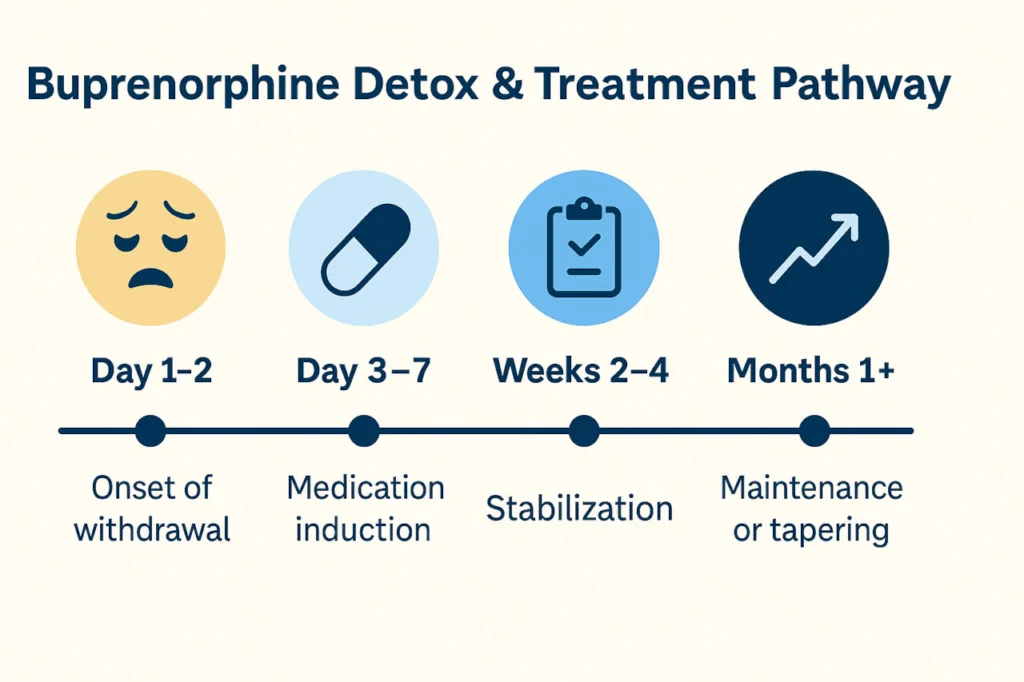How Buprenorphine Helps Treat Opioid Addiction
The thought of recovery may seem like an impossible challenge for individuals struggling with opioid addiction. At one time, the answer to opioid withdrawal was to take the “cold turkey” approach. This can be incredibly uncomfortable and even dangerous without the use of buprenorphine in some cases.
Now, there are better and safer options that include the use of medication assisted treatment (MAT) along with evidenced based behavioral therapies and individual and group counseling to make this challenge a little easier.

MAT has been shown to reduce withdrawal symptoms, curb cravings and help reduce relapse rates in people with opioid addiction. One of the most common medications used for this treatment is buprenorphine.
What Is Buprenorphine?
Buprenorphine is a synthetic opioid that was first developed in the late 1960s to treat pain. It was approved by the FDA to treat opioid use disorder in 2002.
Buprenorphine can be used alone (Subutex) or in combination with naloxone (Suboxone) to treat opioid use disorder. The use of MAT lessens withdrawal symptoms and curbs cravings that can impact an individual’s ability to achieve and maintain recovery.
The use of medications such as buprenorphine reduces the risk of overdose, decreases the transmission of infectious disease and lessens criminal activity associated with substance use disorder.
How Does Buprenorphine Work?
Buprenorphine is a partial opioid receptor agonist. This means it binds to opioid receptors in the brain like morphine or heroin but does not fully activate them which results in less risk of respiratory suppression and euphoria.
Unlike other opioids, it has a ceiling effect. This means that, beyond a certain dose, the effects of the medication do not increase with higher doses. It is considered an opioid and is registered as a Schedule III drug which has a moderate to low potential for physical dependence. It can be used alone or in combination with naloxone to reduce withdrawal symptoms and curb cravings.
What Is Buprenorphine Used For?
Buprenorphine is one of three medications used to treat opioid use disorder (OUD). It works by partially blocking opioid receptors in the brain, lessening withdrawal symptoms and curbing drug cravings. It is considered an opioid but it does not have the same euphoria or risk of overdose as other opioids. When it is combined with naloxone, the risk of misuse decreases.
Buprenorphine vs Other Medications
Until 2002, methadone was the only drug approved to treat OUD. It is still used but buprenorphine and the combination of buprenorphine/naloxone (Suboxone) have a safer use profile.
Methadone is an opioid agonist and activates the mu-opioid receptors in the brain just as heroin or fentanyl does but at a slower rate. It also remains in the body for longer and has the potential to cause serious respiratory distress and overdose.
Buprenorphine in Rehab Settings
It is important to remember that the use of these medications should always be under the close supervision of a qualified medical provider. They should be used in conjunction with an individualized treatment plan that includes behavioral therapy and psychotherapy and peer groups to support long term sobriety.

Buprenorphine may also be used to treat chronic pain especially when other pain medications have not been effective or are poorly tolerated. It is 20 to 50 times more potent than morphine. Medical providers prescribe this medication over others because of the ceiling effect and the lower risk of respiratory depression compared to other commonly used pain medications.
Side Effects and Safety Profile
Known side effects of buprenorphine include:
- Constipation, headache, nausea and vomiting
- Dizziness
- Drowsiness and fatigue
- Sweating
- Dry mouth
- Tooth decay
- Muscle aches and cramps
- Inability to sleep
- Fever
- Blurred vision or dilated pupils
- Tremors
- Palpitations
- Disturbance in attention
- Chills
- Cough
- Fever
- Hoarseness
- Lower back or side pain
- Painful or difficult urination
- Lack or loss of strength
Serious side effects of buprenorphine include:
- Respiratory distress
- Overdose
- Adrenal insufficiency
- Dependence
- Withdrawal
- Itching, pain, swelling and nerve damage (from the implant)
- Pain at the injection site
- Neonatal abstinence syndrome
- Anaphylaxis
Because Suboxone contains buprenorphine, the medications share the same potential side effects. However, those on Suboxone may also experience headaches, nausea, and flushing, potentially due to the presence of naloxone.
How Long Does Buprenorphine Stay in Your System?
Buprenorphine has an average half life of approximately 38 hours. The term half life refers to the time it takes for half of the drug to be broken down and eliminated from the body. The exact amount of time it takes an individual to break down buprenorphine depends on several factors including route, metabolism rate and co-morbid conditions such as liver disease.
Buprenorphine comes in intravenous or intramuscular, transdermal and buccal or sublingual forms. The method of administration and the dosage also affect how long it stays in the system.
Buprenorphine remains detectable in urine for about seven to 10 days, in serum blood tests for up to nine days and on a hair follicle test for one to three months. Some long acting forms such as Sublocade can be detected for between 22 and 38 months following administration.
Buprenorphine Withdrawal and Tapering Off
Individuals who wish to discontinue the use of buprenorphine should always follow a gradual tapering schedule under the supervision of a qualified medical provider. The amount of time it will take to fully withdraw depends on factors such as duration of use, dosage and other comorbid conditions. In some cases, this could take weeks or months.
Symptoms of buprenorphine withdrawal include:
- Anxiety
- Fever
- Nausea
- Runny nose
- Stomach cramps
- Sweating
- Tremors
- Insomnia
Individuals who are withdrawing from buprenorphine may need other medications such as antiemetics to control nausea and vomiting, sleeping medications to improve sleep and in some cases benzodiazepines or other anxiolytic medications to ease symptoms of anxiety and tremors. Supportive therapies including nutrition, exercise, meditation, yoga or acupuncture can also be helpful.
Finding a Rehab Center That Offers Buprenorphine
The use of MAT has become the gold standard for opioid use disorder treatment so programs that offer this service have become much more accessible.

Individuals should look for a treatment facility that follows the highest safety protocols and has medical providers who are trained in dispensing medications such as buprenorphine for the treatment of OUD. Inpatient treatment that offers detox and MAT should have around the clock medical supervision to provide support and emergency interventions when needed. Finding a Substance and Mental Health Services Administration (SAMHSA) certified opioid treatment program can also help ensure that the program is offering the latest evidence based care.
In the outpatient setting, medical providers who have a DEA license to prescribe controlled medications can now prescribe buprenorphine and other FDA approved medications to treat OUD from their primary care office. They can even do so from a telehealth appointment in some cases.
The use of MAT is covered by most commercial insurance plans as well as Medicaid, Medicare, VA benefits, Tricare and Indian Health Services. It is important to consult with your insurance provider and treatment facility before starting any rehab programs to ensure coverage and discuss any out of pocket expenses such as deductibles that may occur.
FAQs
Yes, buprenorphine is a narcotic. Any opioid is considered a narcotic so buprenorphine can be called a narcotic or an opioid. Buprenorphine is considered a Schedule III medication on the DEA schedule of controlled drugs.
No, buprenorphine is one of the two medications in the drug called Suboxone. The other ingredient is naloxone.
Yes, drowsiness and sleepiness are considered common side effects of buprenorphine. For some individuals these symptoms lessen or subside after taking the medication for a period. Caution must be used when driving or handling heavy machinery or until you know exactly how you will respond to its use.
The time it takes for buprenorphine to work depends on the route the medication is taken.
When taken by mouth (Subutex) in tablet form the effects are usually noticeable within one to two hours with the positive effects lasting for up to eight hours.
The sublingual or buccal form (Belbuca) has a rapid onset and lasts for up to 12 hours. This is the preferred route because it bypasses the first pass metabolism that impacts the absorption of the pill form directly reaching the circulatory system.
Using Buprenorphine in MAT
Medication assisted treatment is a critical component in the treatment of opioid use disorder. When MAT is used along with psychotherapy and behavioral changes, recovery is possible. The use of MAT including the use of buprenorphine has been shown to decrease the risk of overdose, ease withdrawal symptoms and curb cravings, lower the risk of infectious disease transmission, lessen criminal activity associated with drug use and help to prevent relapse.
The stigma surrounding the use of MAT for opioid use disorder is due to the fact that this method has been seen as substituting one addiction for another. However the use of FDA approved medications such as buprenorphine is life saving.
The first step is often the hardest, but it is life changing and it starts by reaching out. Contact your primary care provider, call a local treatment center, search online for evidence based treatment programs that include the use of medication assisted treatment or contact support lines that can put you in touch with the support you need. Recovery is possible and so worth the work!
Specialty Treatment Options

Medical Detox
Medical Detox: Cost, Timeline, & What to Expect For those struggling with substance abuse, medical detox is a critical step

Inpatient Drug Rehab
Inpatient Drug Rehab: What to Expect & How Much it Costs According to the National Center for Drug Abuse Statistics

Outpatient Drug Rehab
Outpatient Drug Rehab: Treatments, Cost, & How to Choose If you or a loved one is dealing with a drug